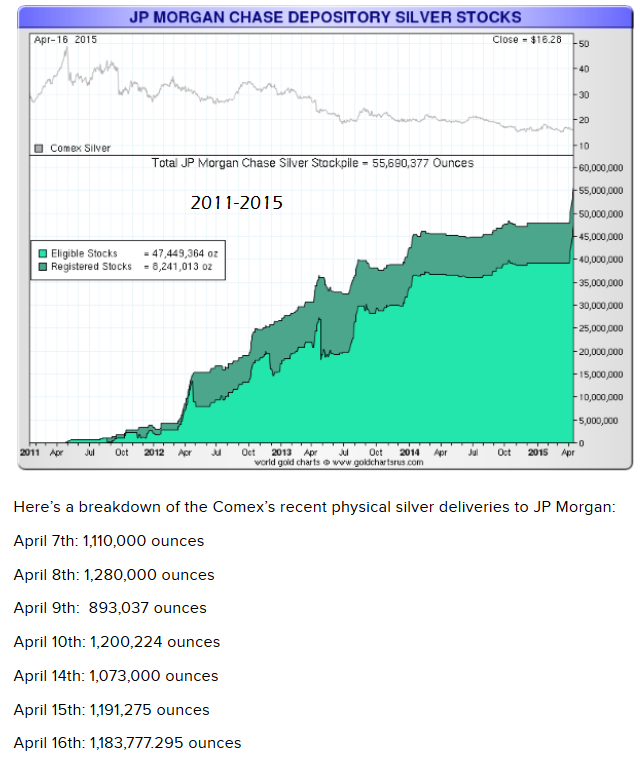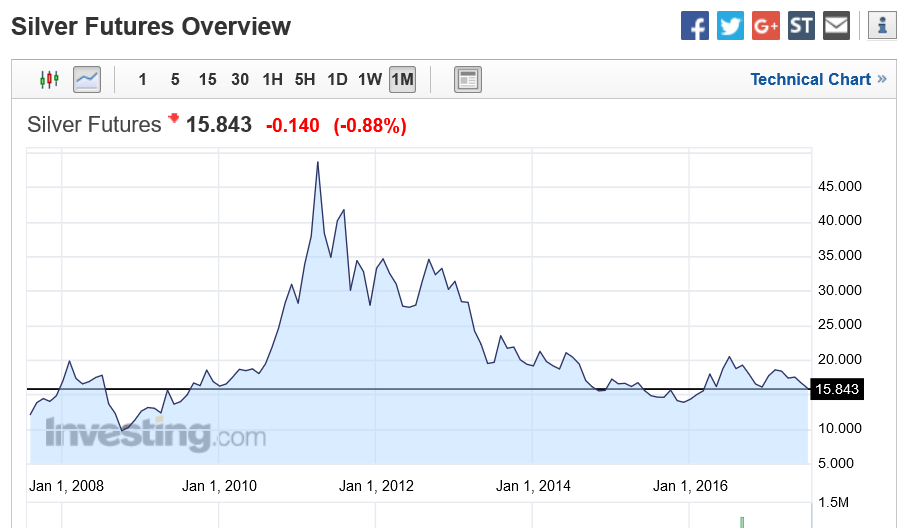Silver Sinks In Market Mystery

Silver took a sudden plunge on Thursday evening (UK Time) just after the US markets closed and just before the Japanese markets opened.
The precious metal lost 10%, tumbling from the day’s open of about 16.10 to lows of 14.55 in a matter of minutes.
The reason for the crash is something of a mystery: it was not triggered by bad news, or any other obvious catalyst, although market participants have their theories.
The main one, is that a ‘fat-finger’, or trading error caused it; and the crash was in fact accidental, an event commonly known as a ‘flash crash’.
Trading errors can happen when either the execution price entered was wrong or the trade size is wrong – or a combination of both.
An overly low execution price on a sell-order for example, will sell the commodity at below market value; if the trade size is also large that will create a massive fall in the price of the asset within seconds as buyers start a frenzy to snap up what they would think is a bargain.
Blackwell Global’s Mathew Ashley, however, sees trader error as an unlikely reason given the wide-ranging checks and balances which trading software is equipped with nowadays.
“As entertaining as the notion is, such mistakes are typically safeguarded against by various fail safes. What’s more, a spike of this size in such a heavily followed market would almost certainly have been picked up prior to execution,” said Ashley.
Although not seen as a cause, the triggering of stoploss orders, may have exacerbated the downtrend.
Stop-losses are used by traders to limit risk as they close long trades when the fall too much, and thus involve selling.
Ashley sees a lack of liquidity as another reason for the sell-off, as it could have widened spreads considerably at the quite interim time when the crash happened.
“One slightly more plausible suggestion has been a sudden liquidity drain that sparked a bout of panic selling. Indeed, markets have been fairly thin over the 4 th of July holiday period which could have compounded fears that silver was becoming illiquid in the wake of JP Morgan’s recent acquisitions,” said Ashley.
The JP Morgan hypothesis is another reason posited for the crash.
JP Morgan have been stockpiling Silver since 2011 after they thought it had reached an undervalued level.
Analysts believe they have built up a huge position in the metal since that time.
“The total JP Morgan silver stockpile has increased dramatically in the last four years. In 2011, JP Morgan has little or no physical silver. By 2012, they had acquired 5 million ounces of silver bullion.

“Incredibly, in the last 3 years (to 2015) their COMEX silver stockpile has increased tenfold and is now over 55 million ounces (see chart below),” said Mark O’Byrne on precious metal site Goldcore.
If JP Morgan have been buying gold since 2011-12 then they must have bought at comparably high prices.
Silver was in the $30s in 2011-12 so any purchases made then would now be significantly ‘underwater’.

Indeed, it is plausible that the fall from the peak made last July at 18.00, may have frightened J P Morgan who might have been tempted to offload some of their stock before Silver went any lower.
Such a move would also make sense in light of the more hawkish rhetoric coming out of central banks since Sintra, based on their more optimistic view of global growth, as well as their own domestic economic growth.
In a world of higher interest rates and stable growth Silver and Gold will lose their safe-haven premium and get even cheaper.
As a consequence of this dawning realisation, a large trader – whether it was J P Morgan or not – may well have been the owner of the ‘fat finger’ which pushed the sell button on Thursday night, although the reasons may not be accidental.
Where Next for Silver?
From a technical perspective, the steep down-move followed the sharp recovery are symptomatic of a type of exhaustion move in the price of an asset which actually augurs bullishly for the outlook.
The ‘long-pin’ or ‘long-tail’ hammer bar which formed on Thursday as a consequence of the crash is actually a bullish indicator and suggests a high probability of more upside ahead for the pair.
It’s not clear how much higher Silver will go but as long as bars keep printing green we advocate a moving two bar stop to follow the rebound up.
We think the 14.55 lows mark a significant low on the chart and are highly unlikely to be breached.




